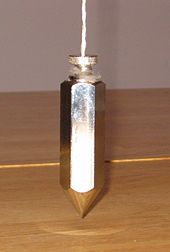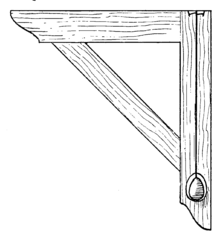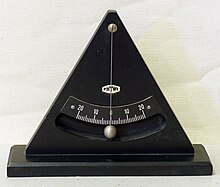Plumb bob

A plumb bob, or plummet, is a weight, usually with a pointed tip on the bottom, suspended from a string and used as a vertical reference line, or plumb-line. It is essentially the vertical equivalent of a "water level".
The instrument has been used since at least the time of ancient Egypt[1] to ensure that constructions are "plumb", or vertical. It is also used in surveying, to establish the nadir with respect to gravity of a point in space. It is used with a variety of instruments (including levels, theodolites, and steel tapes) to set the instrument exactly over a fixed survey marker or to transcribe positions onto the ground for placing a marker.[2]
Etymology


The "plumb" in "plumb-bob" comes from the fact that such tools were originally made of lead (Latin: plumbum, French: plomb). The adjective "plumb" developed by extension, as did the noun "aplomb," from the notion of "standing upright."
Use
Until the modern age, plumb-bobs were used on most tall structures to provide vertical datum lines for the building measurements. A section of the scaffolding would hold a plumb line, which was centered over a datum mark on the floor. As the building proceeded upward, the plumb line would also be taken higher, still centered on the datum. Many cathedral spires, domes and towers still have brass datum marks inlaid into their floors, which signify the center of the structure above.[citation needed]

Although a plumb-bob and line alone can determine only a vertical if they are mounted on a suitable scale, the instrument may also be used as an inclinometer to measure angles to the vertical.
The early skyscrapers used heavy plumb-bobs, hung on wire in their elevator shafts.
A plumb bob may be in a container of water (when conditions are above freezing temperatures), molasses, very viscous oils or other liquids to dampen any swinging movement,[3] functioning as a shock absorber.
Determining center of gravity of an irregular shape
Students of figure drawing will also make use of a plumb line to find the vertical axis through the center of gravity of their subject and lay it down on paper as a point of reference. The device used may be purpose-made plumb lines, or simply makeshift devices made from a piece of string and a weighted object, such as a metal washer. This plumb line is important for lining up anatomical geometries and visualizing the subject's center of balance.[citation needed]
See also
- Bob (physics)
- Centre of mass – used to find the centre of mass on a 2D shape (flat object) which has uniform density
- Chalk line
- Gravity direction
- Vertical direction
References
- ^ Denys A. Stocks. Experiments in Egyptian archaeology: stoneworking technology in ancient Egypt. Routledge; 2003. ISBN 978-0-415-30664-5. p. 180.
- ^ Brinker, Russell Charles; Minnick, Roy, eds. (1995). The surveying handbook. Springer. pp. 93–94. ISBN 978-0-412-98511-9.
- ^ Staley, W. W.. Introduction to mine surveying,. 2nd ed. Stanford University, Calif.: Stanford University Press, 1964. Print. 138.
